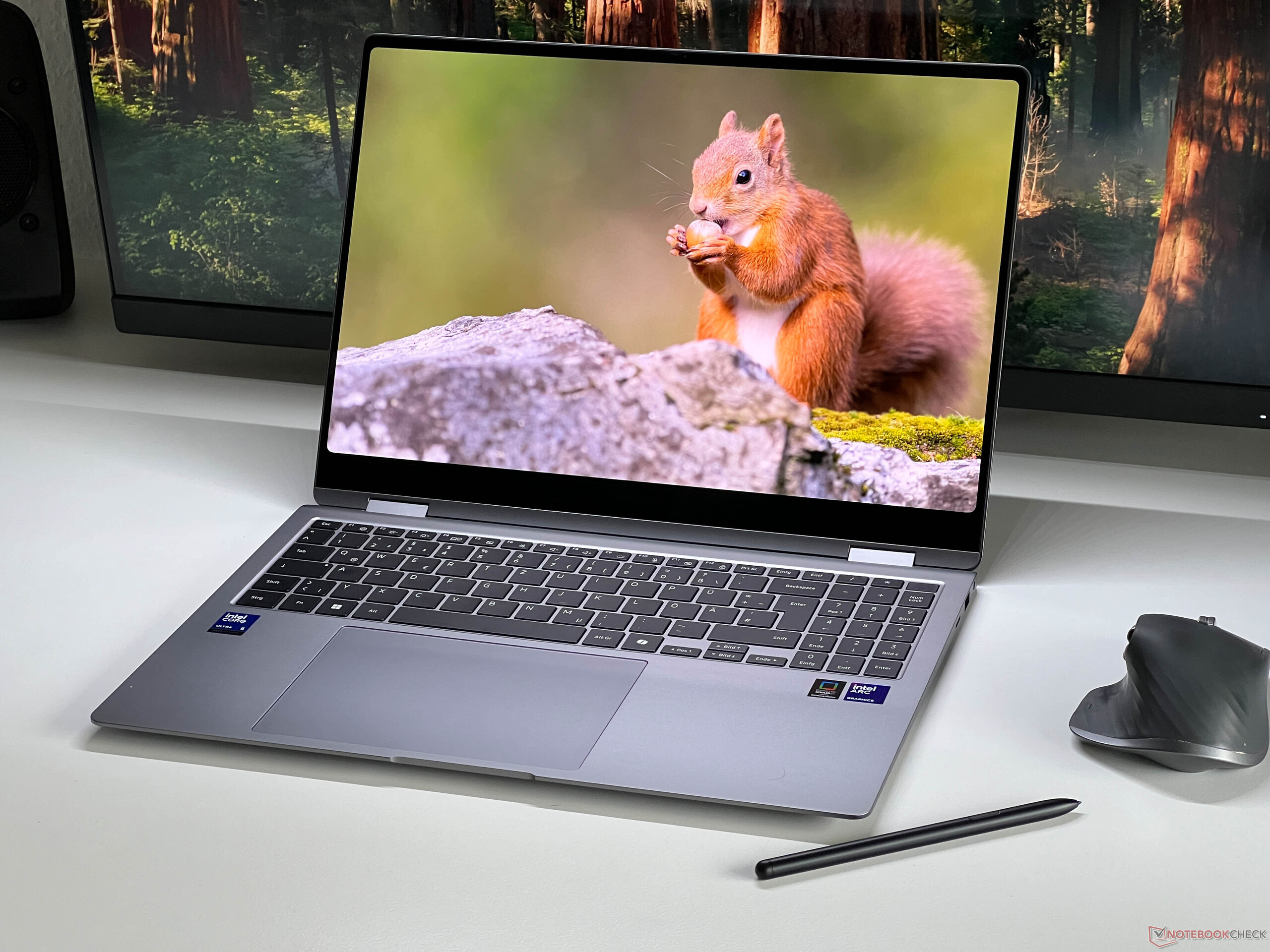
Análisis del portátil Samsung Galaxy Book5 Pro 360 - El gran convertible OLED se beneficia de Intel Lunar Lake
Ahora un PC Copilot+.
Samsung ha dotado a su gran convertible de 16 pulgadas Galaxy Book5 Pro 360 del último procesador Lunar Lake de Intel, que viene con muchas ventajas. Aparte de esto, el dispositivo sigue presumiendo de una carcasa delgada, así como de una impresionante pantalla AMOLED de 120 Hz.Andreas Osthoff, 👁 Andreas Osthoff (traducido por DeepL / Ninh Duy) Publicado 🇺🇸 🇩🇪 ...
Veredicto - El Galaxy Book5 Pro 360 tiene más aguante gracias a Lunar Lake
El Galaxy Book5 Pro 360 sigue siendo un convertible de 16 pulgadas delgado y de alta calidad en su 5ª generación. Aunque su nuevo procesador Intel Lunar Lake no ofrece en general mucho más rendimiento que antes, los usuarios siguen beneficiándose de una menor actividad del ventilador y de una duración de la batería notablemente mayor. Como PC Copilot+, además es compatible con las funciones avanzadas de IA de Windows. Otra mejora es su módulo Wi-Fi 7.
Su carcasa no ha cambiado, por lo que sigue presentando la misma alta calidad que antes. Hay suficientes puertos y tanto el panel AMOLED como los altavoces son excelentes. El teclado del portátil sufre un poco por su escaso recorrido, pero la pantalla táctil y el S-Pen incluido funcionan muy bien.
Las principales desventajas son su memoria RAM no ampliable y su precio de gama alta. Algo más de 1.800 dólares por un Core Ultra 5, 16 GB de RAM y una SSD de 512 GB no es desde luego ninguna ganga. El HP Spectre x360 con procesador Meteor Lake sigue siendo una muy buena alternativa, especialmente si también está a la caza de un teclado mejor. El rendimiento de su procesador AMD es además superior, mientras que la autonomía de su batería es menor.
Pro
Contra
Precio y disponibilidad
Una versión del dispositivo con un Intel Core Ultra 7, 16 GB de RAM y una unidad SSD de 1 TB puede encontrarse actualmente en Amazon por un precio reducido de 1.599,99 dólares.
Posibles contendientes en la comparación
Imagen | Modelo | Precio | Peso | Altura | Pantalla |
|---|---|---|---|---|---|
| Samsung Galaxy Book5 Pro 360 Intel Core Ultra 5 226V ⎘ Intel Arc Graphics 130V ⎘ 16 GB Memoría, 512 GB SSD | Amazon: $1,699.99 Precio de catálogo: 1799€ | 1.7 kg | 12.8 mm | 16.00" 2880x1800 212 PPI OLED | |
| MSI Summit A16 AI Plus A3HMTG AMD Ryzen AI 9 365 ⎘ AMD Radeon 880M ⎘ 32 GB Memoría | Amazon: $1,599.99 Precio de catálogo: 1600 USD | 2.1 kg | 16.85 mm | 16.00" 2560x1600 189 PPI IPS | |
| Dell Inspiron 16 7640 2-in-1 Intel Core Ultra 7 155H ⎘ Intel Arc 8-Core iGPU ⎘ 16 GB Memoría, 1024 GB SSD | Amazon: $999.00 Precio de catálogo: 1000 USD | 2.1 kg | 18.99 mm | 16.00" 2560x1600 189 PPI Mini-LED | |
| HP Envy x360 2-in-1 16-ad0097nr AMD Ryzen 7 8840HS ⎘ AMD Radeon 780M ⎘ 16 GB Memoría, 1024 GB SSD | Amazon: 1. $745.99 HP Envy x360 2-in-1 Laptop, ... 2. $799.98 HP Envy 2-in-1 16" 2K Touch-... 3. $1,399.00 HP Envy x360 2-in-1 16 2024 ... Precio de catálogo: 1300 USD | 1.8 kg | 18.3 mm | 16.00" 2880x1800 212 PPI OLED | |
| LG gram Pro 2-in-1 16T90SP Intel Core Ultra 7 155H ⎘ Intel Arc 8-Core iGPU ⎘ 16 GB Memoría, 1024 GB SSD | Amazon: $1,885.08 Precio de catálogo: 1850€ | 1.4 kg | 12.9 mm | 16.00" 2880x1800 212 PPI OLED | |
| Samsung Galaxy Book4 Pro 360 Intel Core Ultra 5 125H ⎘ Intel Arc 7-Core iGPU ⎘ 16 GB Memoría, 512 GB SSD | Amazon: 1. $1,099.99 SAMSUNG 16' Galaxy Book4 Pro... 2. $1,699.99 SAMSUNG 16” Galaxy Book5 P... 3. $1,349.99 SAMSUNG Galaxy Book3 Pro 360... Precio de catálogo: 1999€ | 1.7 kg | 13 mm | 16.00" 2880x1800 212 PPI OLED | |
| Lenovo Yoga 7 2-in-1 16IML9 Intel Core Ultra 5 125U ⎘ Intel Graphics 4-Core iGPU (Arc) ⎘ 16 GB Memoría, 512 GB SSD | Amazon: $728.09 Precio de catálogo: 900 USD | 2.1 kg | 16.99 mm | 16.00" 1920x1200 142 PPI IPS |
Samsung ha actualizado su gran convertible de 16 pulgadas, equipando ahora el nuevo Galaxy Book5 Pro 360 con un nuevo procesador Lunar Lake de Intel. Esto debería traducirse en ventajas en lo que respecta a la eficiencia, así como al rendimiento de la batería en particular. Además, ahora es oficialmente un PC Copilot+ con funciones avanzadas de IA. Nada ha cambiado en cuanto a su gran pantalla táctil AMOLED, y sigue incluyendo un S-Pen. Nuestra configuración de prueba con el Core Ultra 5 226V, 16 GB de RAM y una unidad SSD de 512 GB cuesta algo más de 1.800 dólares.
Especificaciones
Top 10 Análisis
» Top 10 Portátiles Multimedia
» Top 10 Portátiles de Juego
» Top 10 Portátiles de Juego ligeros
» Top 10 Portátiles Asequibles de Oficina/Empresa
» Top 10 Portátiles de Juego Ligeros
» Top 10 Portátiles de Oficina/Empresa Premium
» Top 10 Estaciones de Trabajo
» Top 10 Subportátiles
» Top 10 Ultrabooks
» Top 10 Convertibles
» Top 10 Tablets
» Top 10 Tablets Windows
» Top 10 Tablets de menos de 250 Euros
» Top 10 Phablets (>5.5")
» Top 10 Smartphones
» Top 10 Smartphones (≤5")
» Top 10 Smartphones de menos de 300 Euros
» Top 10 Smartphones de menos de 120 Euros
» Top 10 Portátiles de menos de 1000 Euros
» Top 10 Portátiles de menos de 500 Euros
» Top 10 Portátiles de menos de 300 Euros
» Los Mejores Displays de Portátiles Analizados por Notebookcheck
Diferencias respecto al Galaxy Book4 Pro 360
En comparación con la Galaxy Book4 Pro 360, nada ha cambiado en cuanto a su carcasa y conectividad, lo que significa que sigue obteniendo un convertible de 16 pulgadas de alta calidad con un grosor superfino de sólo 12,8 mm. Sus superficies metálicas de color gris oscuro no atraen tantas marcas de huellas dactilares y, desde el punto de vista de la calidad, no tenemos nada de lo que quejarnos. Sólo la ancha parte inferior del marco que rodea la pantalla parece un poco fuera de lugar y hace que la carcasa sea relativamente profunda. La cubierta inferior es fácil de quitar (los tornillos están ocultos bajo las patas de goma) y puede acceder a los ventiladores, la batería y la SSD M.2 2280. Todos los demás componentes, en cambio, están soldados.
Junto con un nuevo procesador, también se ha actualizado su módulo WLAN: el nuevo módulo BE201 de Intel es compatible con Wi-Fi 7 y Bluetooth 5.4. Su cámara web de 1080p es compatible con las funciones avanzadas de Studio, pero su calidad de imagen es, por desgracia, sólo media.
Al igual que el modelo anterior, su teclado sufre un poco por el corto recorrido de sus teclas y la competencia ofrece mejores opciones de entrada, como el HP Envy x360. Su gran clickpad cuenta ahora con un rechazo de la palma de la mano mejorado, aunque tampoco tuvimos problemas con esto en el modelo antiguo.
| SD Card Reader | |
| average JPG Copy Test (av. of 3 runs) | |
| MSI Summit A16 AI Plus A3HMTG (AV Pro SD microSD 128 GB V60) | |
| Lenovo Yoga 7 2-in-1 16IML9 (AV Pro SD microSD 128 GB V60) | |
| Samsung Galaxy Book4 Pro 360 (Angelbird AV Pro V60) | |
| Media de la clase Convertible (22.4 - 209, n=28, últimos 2 años) | |
| Samsung Galaxy Book5 Pro 360 (Angelbird AV Pro V60) | |
| Dell Inspiron 16 7640 2-in-1 (Toshiba Exceria Pro SDXC 64 GB UHS-II) | |
| maximum AS SSD Seq Read Test (1GB) | |
| MSI Summit A16 AI Plus A3HMTG (AV Pro SD microSD 128 GB V60) | |
| Media de la clase Convertible (25.2 - 263, n=27, últimos 2 años) | |
| Lenovo Yoga 7 2-in-1 16IML9 (AV Pro SD microSD 128 GB V60) | |
| Samsung Galaxy Book4 Pro 360 (Angelbird AV Pro V60) | |
| Samsung Galaxy Book5 Pro 360 (Angelbird AV Pro V60) | |
| Dell Inspiron 16 7640 2-in-1 (Toshiba Exceria Pro SDXC 64 GB UHS-II) | |
| Networking | |
| Samsung Galaxy Book5 Pro 360 | |
| iperf3 transmit AXE11000 | |
| iperf3 receive AXE11000 | |
| MSI Summit A16 AI Plus A3HMTG | |
| iperf3 transmit AXE11000 | |
| iperf3 receive AXE11000 | |
| iperf3 transmit AXE11000 6GHz | |
| iperf3 receive AXE11000 6GHz | |
| Dell Inspiron 16 7640 2-in-1 | |
| iperf3 transmit AXE11000 | |
| iperf3 receive AXE11000 | |
| iperf3 transmit AXE11000 6GHz | |
| iperf3 receive AXE11000 6GHz | |
| HP Envy x360 2-in-1 16-ad0097nr | |
| iperf3 transmit AXE11000 | |
| iperf3 receive AXE11000 | |
| iperf3 transmit AXE11000 6GHz | |
| iperf3 receive AXE11000 6GHz | |
| LG gram Pro 2-in-1 16T90SP | |
| iperf3 transmit AXE11000 | |
| iperf3 receive AXE11000 | |
| iperf3 transmit AXE11000 6GHz | |
| iperf3 receive AXE11000 6GHz | |
| Samsung Galaxy Book4 Pro 360 | |
| iperf3 transmit AXE11000 | |
| iperf3 receive AXE11000 | |
| Lenovo Yoga 7 2-in-1 16IML9 | |
| iperf3 transmit AXE11000 | |
| iperf3 receive AXE11000 | |
| iperf3 transmit AXE11000 6GHz | |
| iperf3 receive AXE11000 6GHz | |

Sostenibilidad
Samsung no ha facilitado ninguna información sobre la huella deCO2 del portátil durante su producción ni sobre el uso de materiales reciclados. Su embalaje está hecho en gran parte de cartón y materiales reciclables. En la página de soporte del fabricante encontrará una guía de reparación.
Pantalla - AMOLED a 120 Hz
El nuevo Galaxy Book5 Pro 360 está equipado exactamente con el mismo panel AMOLED que su predecesor (ATNA60CL09-0), por lo que recomendamos la lectura de nuestro análisis del Galaxy Book4 Pro 360 para obtener información más detallada. Subjetivamente, su pantalla táctil AMOLED ofrece una excelente calidad de imagen con colores ricos y una relación de contraste extremadamente alta. Sus tiempos de respuesta son superrápidos y los movimientos parecen muy fluidos gracias a su frecuencia de refresco de 120-Hz. Sin embargo, se utiliza PWM de 240-Hz en todos los niveles de brillo. Samsung proporciona varios perfiles de color y también hay un modo sRGB (P3 y sRGB están totalmente cubiertos).
Rendimiento - Intel Lunar Lake y RAM más rápida
Condiciones de prueba
Al igual que su predecesor, Samsung ofrece varios modos de rendimiento en la aplicación Ajustes(Alto rendimiento, Optimizado, Silencioso, Silencioso), pero ahora están vinculados a los ajustes de Windows. Esto no era así antes, pero ahora resulta más cómodo para el usuario. Hemos utilizado el perfil de mejor rendimiento de Windows para los siguientes puntos de referencia y mediciones, que ahora selecciona automáticamente el modo de alto rendimiento de Samsung.
Procesador
Samsung ha apostado por el nuevo Intel Core Ultra 5 226V de la generación Lunar Lake, que está diseñado principalmente para la eficiencia. Cuenta con cuatro núcleos de rendimiento rápido y cuatro núcleos de eficiencia, por lo que el chip puede consumir hasta 37 vatios en total. Esto lo sitúa muy por debajo de las antiguas CPU Meteor Lake, como la Core Ultra 5 125H del modelo predecesor. En el modo de rendimiento, el procesador consumió inicialmente los 37 vatios completos y luego se estabilizó en 30 vatios (64/30 vatios en el modelo predecesor), por lo que su rendimiento multinúcleo se mantuvo muy estable en general. Sin embargo, también hay que decir que su rendimiento multinúcleo se situó sólo ligeramente por encima del antiguo Core Ultra 5 125H y no pudo seguir el ritmo de los procesadores AMD. En general, sin embargo, su rendimiento es suficiente para la mayoría de las tareas cotidianas. Su rendimiento no se reduce en modo batería. Encontrará más pruebas de rendimiento de la CPU en nuestra sección de tecnología.
Cinebench R15 Multi continuous test
Cinebench R23: Multi Core | Single Core
Cinebench R20: CPU (Multi Core) | CPU (Single Core)
Cinebench R15: CPU Multi 64Bit | CPU Single 64Bit
Blender: v2.79 BMW27 CPU
7-Zip 18.03: 7z b 4 | 7z b 4 -mmt1
Geekbench 6.4: Multi-Core | Single-Core
Geekbench 5.5: Multi-Core | Single-Core
HWBOT x265 Benchmark v2.2: 4k Preset
LibreOffice : 20 Documents To PDF
R Benchmark 2.5: Overall mean
| CPU Performance Rating | |
| MSI Summit A16 AI Plus A3HMTG | |
| Dell Inspiron 16 7640 2-in-1 | |
| LG gram Pro 2-in-1 16T90SP -2! | |
| HP Envy x360 2-in-1 16-ad0097nr | |
| Samsung Galaxy Book5 Pro 360 | |
| Media de la clase Convertible | |
| Samsung Galaxy Book4 Pro 360 -1! | |
| Medio Intel Core Ultra 5 226V | |
| Lenovo Yoga 7 2-in-1 16IML9 | |
| Cinebench R23 / Multi Core | |
| MSI Summit A16 AI Plus A3HMTG | |
| Dell Inspiron 16 7640 2-in-1 | |
| HP Envy x360 2-in-1 16-ad0097nr | |
| LG gram Pro 2-in-1 16T90SP | |
| Media de la clase Convertible (2949 - 29063, n=65, últimos 2 años) | |
| Samsung Galaxy Book4 Pro 360 | |
| Medio Intel Core Ultra 5 226V (9827 - 9940, n=4) | |
| Samsung Galaxy Book5 Pro 360 | |
| Lenovo Yoga 7 2-in-1 16IML9 | |
| Cinebench R23 / Single Core | |
| MSI Summit A16 AI Plus A3HMTG | |
| Dell Inspiron 16 7640 2-in-1 | |
| Samsung Galaxy Book5 Pro 360 | |
| HP Envy x360 2-in-1 16-ad0097nr | |
| Medio Intel Core Ultra 5 226V (1699 - 1749, n=4) | |
| Samsung Galaxy Book4 Pro 360 | |
| LG gram Pro 2-in-1 16T90SP | |
| Media de la clase Convertible (914 - 2163, n=65, últimos 2 años) | |
| Lenovo Yoga 7 2-in-1 16IML9 | |
| Cinebench R20 / CPU (Multi Core) | |
| MSI Summit A16 AI Plus A3HMTG | |
| Dell Inspiron 16 7640 2-in-1 | |
| HP Envy x360 2-in-1 16-ad0097nr | |
| LG gram Pro 2-in-1 16T90SP | |
| Media de la clase Convertible (1124 - 11357, n=64, últimos 2 años) | |
| Samsung Galaxy Book4 Pro 360 | |
| Medio Intel Core Ultra 5 226V (3835 - 3885, n=4) | |
| Samsung Galaxy Book5 Pro 360 | |
| Lenovo Yoga 7 2-in-1 16IML9 | |
| Cinebench R20 / CPU (Single Core) | |
| MSI Summit A16 AI Plus A3HMTG | |
| Samsung Galaxy Book5 Pro 360 | |
| Dell Inspiron 16 7640 2-in-1 | |
| Medio Intel Core Ultra 5 226V (653 - 674, n=4) | |
| Samsung Galaxy Book4 Pro 360 | |
| LG gram Pro 2-in-1 16T90SP | |
| HP Envy x360 2-in-1 16-ad0097nr | |
| Media de la clase Convertible (348 - 827, n=64, últimos 2 años) | |
| Lenovo Yoga 7 2-in-1 16IML9 | |
| Cinebench R15 / CPU Multi 64Bit | |
| MSI Summit A16 AI Plus A3HMTG | |
| Dell Inspiron 16 7640 2-in-1 | |
| LG gram Pro 2-in-1 16T90SP | |
| LG gram Pro 2-in-1 16T90SP | |
| HP Envy x360 2-in-1 16-ad0097nr | |
| Media de la clase Convertible (478 - 4830, n=67, últimos 2 años) | |
| Samsung Galaxy Book4 Pro 360 | |
| Lenovo Yoga 7 2-in-1 16IML9 | |
| Medio Intel Core Ultra 5 226V (1483 - 1514, n=4) | |
| Samsung Galaxy Book5 Pro 360 | |
| Cinebench R15 / CPU Single 64Bit | |
| MSI Summit A16 AI Plus A3HMTG | |
| Samsung Galaxy Book5 Pro 360 | |
| Medio Intel Core Ultra 5 226V (261 - 270, n=4) | |
| HP Envy x360 2-in-1 16-ad0097nr | |
| Dell Inspiron 16 7640 2-in-1 | |
| Media de la clase Convertible (149.8 - 317, n=64, últimos 2 años) | |
| Samsung Galaxy Book4 Pro 360 | |
| LG gram Pro 2-in-1 16T90SP | |
| Lenovo Yoga 7 2-in-1 16IML9 | |
| Blender / v2.79 BMW27 CPU | |
| Samsung Galaxy Book4 Pro 360 | |
| Lenovo Yoga 7 2-in-1 16IML9 | |
| Media de la clase Convertible (107 - 1051, n=62, últimos 2 años) | |
| Medio Intel Core Ultra 5 226V (346 - 355, n=4) | |
| Samsung Galaxy Book5 Pro 360 | |
| LG gram Pro 2-in-1 16T90SP | |
| HP Envy x360 2-in-1 16-ad0097nr | |
| Dell Inspiron 16 7640 2-in-1 | |
| MSI Summit A16 AI Plus A3HMTG | |
| 7-Zip 18.03 / 7z b 4 | |
| MSI Summit A16 AI Plus A3HMTG | |
| Dell Inspiron 16 7640 2-in-1 | |
| HP Envy x360 2-in-1 16-ad0097nr | |
| LG gram Pro 2-in-1 16T90SP | |
| Media de la clase Convertible (12977 - 121368, n=64, últimos 2 años) | |
| Lenovo Yoga 7 2-in-1 16IML9 | |
| Medio Intel Core Ultra 5 226V (33099 - 33302, n=3) | |
| Samsung Galaxy Book5 Pro 360 | |
| 7-Zip 18.03 / 7z b 4 -mmt1 | |
| HP Envy x360 2-in-1 16-ad0097nr | |
| MSI Summit A16 AI Plus A3HMTG | |
| Dell Inspiron 16 7640 2-in-1 | |
| Samsung Galaxy Book5 Pro 360 | |
| Medio Intel Core Ultra 5 226V (5272 - 5335, n=3) | |
| Media de la clase Convertible (3672 - 6540, n=64, últimos 2 años) | |
| LG gram Pro 2-in-1 16T90SP | |
| Samsung Galaxy Book4 Pro 360 | |
| Lenovo Yoga 7 2-in-1 16IML9 | |
| Geekbench 6.4 / Multi-Core | |
| MSI Summit A16 AI Plus A3HMTG | |
| Dell Inspiron 16 7640 2-in-1 | |
| Samsung Galaxy Book4 Pro 360 | |
| HP Envy x360 2-in-1 16-ad0097nr | |
| LG gram Pro 2-in-1 16T90SP | |
| Media de la clase Convertible (2291 - 21269, n=55, últimos 2 años) | |
| Medio Intel Core Ultra 5 226V (9850 - 10151, n=4) | |
| Samsung Galaxy Book5 Pro 360 | |
| Lenovo Yoga 7 2-in-1 16IML9 | |
| Geekbench 6.4 / Single-Core | |
| MSI Summit A16 AI Plus A3HMTG | |
| Samsung Galaxy Book5 Pro 360 | |
| Medio Intel Core Ultra 5 226V (2527 - 2584, n=4) | |
| HP Envy x360 2-in-1 16-ad0097nr | |
| Dell Inspiron 16 7640 2-in-1 | |
| Media de la clase Convertible (1003 - 2978, n=56, últimos 2 años) | |
| Samsung Galaxy Book4 Pro 360 | |
| Lenovo Yoga 7 2-in-1 16IML9 | |
| LG gram Pro 2-in-1 16T90SP | |
| Geekbench 5.5 / Multi-Core | |
| MSI Summit A16 AI Plus A3HMTG | |
| Dell Inspiron 16 7640 2-in-1 | |
| LG gram Pro 2-in-1 16T90SP | |
| HP Envy x360 2-in-1 16-ad0097nr | |
| Samsung Galaxy Book4 Pro 360 | |
| Media de la clase Convertible (2188 - 22023, n=64, últimos 2 años) | |
| Samsung Galaxy Book5 Pro 360 | |
| Medio Intel Core Ultra 5 226V (8704 - 8995, n=4) | |
| Lenovo Yoga 7 2-in-1 16IML9 | |
| Geekbench 5.5 / Single-Core | |
| MSI Summit A16 AI Plus A3HMTG | |
| HP Envy x360 2-in-1 16-ad0097nr | |
| Samsung Galaxy Book5 Pro 360 | |
| Medio Intel Core Ultra 5 226V (1852 - 1888, n=4) | |
| Dell Inspiron 16 7640 2-in-1 | |
| LG gram Pro 2-in-1 16T90SP | |
| Media de la clase Convertible (806 - 2275, n=64, últimos 2 años) | |
| Samsung Galaxy Book4 Pro 360 | |
| Lenovo Yoga 7 2-in-1 16IML9 | |
| HWBOT x265 Benchmark v2.2 / 4k Preset | |
| MSI Summit A16 AI Plus A3HMTG | |
| Dell Inspiron 16 7640 2-in-1 | |
| HP Envy x360 2-in-1 16-ad0097nr | |
| Samsung Galaxy Book5 Pro 360 | |
| Medio Intel Core Ultra 5 226V (12.2 - 12.8, n=4) | |
| Media de la clase Convertible (3.43 - 36.2, n=64, últimos 2 años) | |
| LG gram Pro 2-in-1 16T90SP | |
| Lenovo Yoga 7 2-in-1 16IML9 | |
| Samsung Galaxy Book4 Pro 360 | |
| LibreOffice / 20 Documents To PDF | |
| Medio Intel Core Ultra 5 226V (45.2 - 61.4, n=4) | |
| MSI Summit A16 AI Plus A3HMTG | |
| Media de la clase Convertible (42.7 - 84.3, n=63, últimos 2 años) | |
| HP Envy x360 2-in-1 16-ad0097nr | |
| Lenovo Yoga 7 2-in-1 16IML9 | |
| Dell Inspiron 16 7640 2-in-1 | |
| Samsung Galaxy Book5 Pro 360 | |
| Samsung Galaxy Book4 Pro 360 | |
| R Benchmark 2.5 / Overall mean | |
| Lenovo Yoga 7 2-in-1 16IML9 | |
| Media de la clase Convertible (0.3985 - 0.84, n=63, últimos 2 años) | |
| Samsung Galaxy Book4 Pro 360 | |
| Medio Intel Core Ultra 5 226V (0.4808 - 0.4873, n=4) | |
| Dell Inspiron 16 7640 2-in-1 | |
| Samsung Galaxy Book5 Pro 360 | |
| HP Envy x360 2-in-1 16-ad0097nr | |
| MSI Summit A16 AI Plus A3HMTG | |
* ... más pequeño es mejor
AIDA64: FP32 Ray-Trace | FPU Julia | CPU SHA3 | CPU Queen | FPU SinJulia | FPU Mandel | CPU AES | CPU ZLib | FP64 Ray-Trace | CPU PhotoWorxx
| Performance Rating | |
| MSI Summit A16 AI Plus A3HMTG | |
| HP Envy x360 2-in-1 16-ad0097nr | |
| Dell Inspiron 16 7640 2-in-1 | |
| LG gram Pro 2-in-1 16T90SP | |
| Media de la clase Convertible | |
| Samsung Galaxy Book5 Pro 360 | |
| Medio Intel Core Ultra 5 226V | |
| Samsung Galaxy Book4 Pro 360 | |
| Lenovo Yoga 7 2-in-1 16IML9 | |
| AIDA64 / FP32 Ray-Trace | |
| MSI Summit A16 AI Plus A3HMTG | |
| HP Envy x360 2-in-1 16-ad0097nr | |
| Dell Inspiron 16 7640 2-in-1 | |
| Samsung Galaxy Book5 Pro 360 | |
| Medio Intel Core Ultra 5 226V (11849 - 12147, n=4) | |
| Media de la clase Convertible (2179 - 64158, n=65, últimos 2 años) | |
| LG gram Pro 2-in-1 16T90SP | |
| Lenovo Yoga 7 2-in-1 16IML9 | |
| Samsung Galaxy Book4 Pro 360 | |
| AIDA64 / FPU Julia | |
| MSI Summit A16 AI Plus A3HMTG | |
| HP Envy x360 2-in-1 16-ad0097nr | |
| Dell Inspiron 16 7640 2-in-1 | |
| Samsung Galaxy Book5 Pro 360 | |
| Medio Intel Core Ultra 5 226V (59169 - 60179, n=4) | |
| Media de la clase Convertible (11392 - 183760, n=64, últimos 2 años) | |
| LG gram Pro 2-in-1 16T90SP | |
| Lenovo Yoga 7 2-in-1 16IML9 | |
| Samsung Galaxy Book4 Pro 360 | |
| AIDA64 / CPU SHA3 | |
| MSI Summit A16 AI Plus A3HMTG | |
| HP Envy x360 2-in-1 16-ad0097nr | |
| Dell Inspiron 16 7640 2-in-1 | |
| Media de la clase Convertible (797 - 8151, n=64, últimos 2 años) | |
| Medio Intel Core Ultra 5 226V (2551 - 2570, n=4) | |
| LG gram Pro 2-in-1 16T90SP | |
| Samsung Galaxy Book5 Pro 360 | |
| Lenovo Yoga 7 2-in-1 16IML9 | |
| Samsung Galaxy Book4 Pro 360 | |
| AIDA64 / CPU Queen | |
| HP Envy x360 2-in-1 16-ad0097nr | |
| MSI Summit A16 AI Plus A3HMTG | |
| Dell Inspiron 16 7640 2-in-1 | |
| Samsung Galaxy Book4 Pro 360 | |
| LG gram Pro 2-in-1 16T90SP | |
| Media de la clase Convertible (22413 - 145339, n=64, últimos 2 años) | |
| Lenovo Yoga 7 2-in-1 16IML9 | |
| Medio Intel Core Ultra 5 226V (46991 - 47087, n=4) | |
| Samsung Galaxy Book5 Pro 360 | |
| AIDA64 / FPU SinJulia | |
| MSI Summit A16 AI Plus A3HMTG | |
| HP Envy x360 2-in-1 16-ad0097nr | |
| Dell Inspiron 16 7640 2-in-1 | |
| LG gram Pro 2-in-1 16T90SP | |
| Media de la clase Convertible (1120 - 29155, n=64, últimos 2 años) | |
| Samsung Galaxy Book4 Pro 360 | |
| Lenovo Yoga 7 2-in-1 16IML9 | |
| Samsung Galaxy Book5 Pro 360 | |
| Medio Intel Core Ultra 5 226V (3909 - 3918, n=4) | |
| AIDA64 / FPU Mandel | |
| MSI Summit A16 AI Plus A3HMTG | |
| HP Envy x360 2-in-1 16-ad0097nr | |
| Dell Inspiron 16 7640 2-in-1 | |
| Samsung Galaxy Book5 Pro 360 | |
| Medio Intel Core Ultra 5 226V (31207 - 32239, n=4) | |
| Media de la clase Convertible (5749 - 97193, n=64, últimos 2 años) | |
| LG gram Pro 2-in-1 16T90SP | |
| Lenovo Yoga 7 2-in-1 16IML9 | |
| Samsung Galaxy Book4 Pro 360 | |
| AIDA64 / CPU AES | |
| Dell Inspiron 16 7640 2-in-1 | |
| HP Envy x360 2-in-1 16-ad0097nr | |
| MSI Summit A16 AI Plus A3HMTG | |
| LG gram Pro 2-in-1 16T90SP | |
| Media de la clase Convertible (21774 - 169089, n=64, últimos 2 años) | |
| Lenovo Yoga 7 2-in-1 16IML9 | |
| Samsung Galaxy Book4 Pro 360 | |
| Medio Intel Core Ultra 5 226V (34159 - 36373, n=4) | |
| Samsung Galaxy Book5 Pro 360 | |
| AIDA64 / CPU ZLib | |
| MSI Summit A16 AI Plus A3HMTG | |
| Dell Inspiron 16 7640 2-in-1 | |
| HP Envy x360 2-in-1 16-ad0097nr | |
| LG gram Pro 2-in-1 16T90SP | |
| Media de la clase Convertible (218 - 2001, n=64, últimos 2 años) | |
| Lenovo Yoga 7 2-in-1 16IML9 | |
| Samsung Galaxy Book4 Pro 360 | |
| Samsung Galaxy Book5 Pro 360 | |
| Medio Intel Core Ultra 5 226V (539 - 572, n=4) | |
| AIDA64 / FP64 Ray-Trace | |
| MSI Summit A16 AI Plus A3HMTG | |
| HP Envy x360 2-in-1 16-ad0097nr | |
| Dell Inspiron 16 7640 2-in-1 | |
| Samsung Galaxy Book5 Pro 360 | |
| Medio Intel Core Ultra 5 226V (6477 - 6673, n=4) | |
| Media de la clase Convertible (1169 - 34297, n=64, últimos 2 años) | |
| LG gram Pro 2-in-1 16T90SP | |
| Samsung Galaxy Book4 Pro 360 | |
| Lenovo Yoga 7 2-in-1 16IML9 | |
| AIDA64 / CPU PhotoWorxx | |
| MSI Summit A16 AI Plus A3HMTG | |
| Medio Intel Core Ultra 5 226V (50038 - 50232, n=4) | |
| Samsung Galaxy Book5 Pro 360 | |
| LG gram Pro 2-in-1 16T90SP | |
| Lenovo Yoga 7 2-in-1 16IML9 | |
| Samsung Galaxy Book4 Pro 360 | |
| Dell Inspiron 16 7640 2-in-1 | |
| Media de la clase Convertible (13761 - 81626, n=64, últimos 2 años) | |
| HP Envy x360 2-in-1 16-ad0097nr | |
Rendimiento del sistema
El Galaxy Book5 Pro 360 es un portátil con una gran capacidad de respuesta y no observamos ningún problema de estabilidad durante nuestra prueba. Los benchmarks sintéticos tampoco mostraron anomalías.
CrossMark: Overall | Productivity | Creativity | Responsiveness
WebXPRT 3: Overall
WebXPRT 4: Overall
Mozilla Kraken 1.1: Total
| PCMark 10 / Score | |
| MSI Summit A16 AI Plus A3HMTG | |
| Dell Inspiron 16 7640 2-in-1 | |
| HP Envy x360 2-in-1 16-ad0097nr | |
| Samsung Galaxy Book5 Pro 360 | |
| Medio Intel Core Ultra 5 226V, Intel Arc Graphics 130V (6445 - 6734, n=4) | |
| LG gram Pro 2-in-1 16T90SP | |
| Samsung Galaxy Book4 Pro 360 | |
| Media de la clase Convertible (3229 - 9125, n=61, últimos 2 años) | |
| Lenovo Yoga 7 2-in-1 16IML9 | |
| PCMark 10 / Essentials | |
| MSI Summit A16 AI Plus A3HMTG | |
| Dell Inspiron 16 7640 2-in-1 | |
| Lenovo Yoga 7 2-in-1 16IML9 | |
| Media de la clase Convertible (7233 - 12005, n=61, últimos 2 años) | |
| Samsung Galaxy Book4 Pro 360 | |
| HP Envy x360 2-in-1 16-ad0097nr | |
| LG gram Pro 2-in-1 16T90SP | |
| Samsung Galaxy Book5 Pro 360 | |
| Medio Intel Core Ultra 5 226V, Intel Arc Graphics 130V (9363 - 10067, n=4) | |
| PCMark 10 / Productivity | |
| HP Envy x360 2-in-1 16-ad0097nr | |
| MSI Summit A16 AI Plus A3HMTG | |
| Samsung Galaxy Book5 Pro 360 | |
| Dell Inspiron 16 7640 2-in-1 | |
| Medio Intel Core Ultra 5 226V, Intel Arc Graphics 130V (8457 - 8977, n=4) | |
| LG gram Pro 2-in-1 16T90SP | |
| Media de la clase Convertible (5062 - 10800, n=61, últimos 2 años) | |
| Samsung Galaxy Book4 Pro 360 | |
| Lenovo Yoga 7 2-in-1 16IML9 | |
| PCMark 10 / Digital Content Creation | |
| MSI Summit A16 AI Plus A3HMTG | |
| Dell Inspiron 16 7640 2-in-1 | |
| Medio Intel Core Ultra 5 226V, Intel Arc Graphics 130V (8983 - 9239, n=4) | |
| Samsung Galaxy Book5 Pro 360 | |
| HP Envy x360 2-in-1 16-ad0097nr | |
| Samsung Galaxy Book4 Pro 360 | |
| LG gram Pro 2-in-1 16T90SP | |
| Media de la clase Convertible (2496 - 16551, n=61, últimos 2 años) | |
| Lenovo Yoga 7 2-in-1 16IML9 | |
| CrossMark / Overall | |
| MSI Summit A16 AI Plus A3HMTG | |
| Dell Inspiron 16 7640 2-in-1 | |
| Lenovo Yoga 7 2-in-1 16IML9 | |
| HP Envy x360 2-in-1 16-ad0097nr | |
| Samsung Galaxy Book4 Pro 360 | |
| Samsung Galaxy Book5 Pro 360 | |
| Medio Intel Core Ultra 5 226V, Intel Arc Graphics 130V (1555 - 1582, n=3) | |
| LG gram Pro 2-in-1 16T90SP | |
| Media de la clase Convertible (524 - 2274, n=64, últimos 2 años) | |
| CrossMark / Productivity | |
| Dell Inspiron 16 7640 2-in-1 | |
| HP Envy x360 2-in-1 16-ad0097nr | |
| MSI Summit A16 AI Plus A3HMTG | |
| Samsung Galaxy Book4 Pro 360 | |
| Samsung Galaxy Book5 Pro 360 | |
| Medio Intel Core Ultra 5 226V, Intel Arc Graphics 130V (1517 - 1539, n=3) | |
| LG gram Pro 2-in-1 16T90SP | |
| Media de la clase Convertible (554 - 1925, n=64, últimos 2 años) | |
| Lenovo Yoga 7 2-in-1 16IML9 | |
| CrossMark / Creativity | |
| MSI Summit A16 AI Plus A3HMTG | |
| Dell Inspiron 16 7640 2-in-1 | |
| HP Envy x360 2-in-1 16-ad0097nr | |
| Samsung Galaxy Book4 Pro 360 | |
| Samsung Galaxy Book5 Pro 360 | |
| Medio Intel Core Ultra 5 226V, Intel Arc Graphics 130V (1720 - 1740, n=3) | |
| LG gram Pro 2-in-1 16T90SP | |
| Media de la clase Convertible (550 - 2949, n=64, últimos 2 años) | |
| Lenovo Yoga 7 2-in-1 16IML9 | |
| CrossMark / Responsiveness | |
| Samsung Galaxy Book4 Pro 360 | |
| Dell Inspiron 16 7640 2-in-1 | |
| MSI Summit A16 AI Plus A3HMTG | |
| HP Envy x360 2-in-1 16-ad0097nr | |
| Samsung Galaxy Book5 Pro 360 | |
| Media de la clase Convertible (381 - 1868, n=64, últimos 2 años) | |
| LG gram Pro 2-in-1 16T90SP | |
| Medio Intel Core Ultra 5 226V, Intel Arc Graphics 130V (1225 - 1289, n=3) | |
| Lenovo Yoga 7 2-in-1 16IML9 | |
| WebXPRT 3 / Overall | |
| MSI Summit A16 AI Plus A3HMTG | |
| HP Envy x360 2-in-1 16-ad0097nr | |
| Dell Inspiron 16 7640 2-in-1 | |
| Medio Intel Core Ultra 5 226V, Intel Arc Graphics 130V (272 - 286, n=3) | |
| Media de la clase Convertible (171 - 426, n=67, últimos 2 años) | |
| LG gram Pro 2-in-1 16T90SP | |
| Samsung Galaxy Book5 Pro 360 | |
| Samsung Galaxy Book4 Pro 360 | |
| Lenovo Yoga 7 2-in-1 16IML9 | |
| WebXPRT 4 / Overall | |
| MSI Summit A16 AI Plus A3HMTG | |
| Samsung Galaxy Book5 Pro 360 | |
| Dell Inspiron 16 7640 2-in-1 | |
| Medio Intel Core Ultra 5 226V, Intel Arc Graphics 130V (249 - 266, n=6) | |
| LG gram Pro 2-in-1 16T90SP | |
| HP Envy x360 2-in-1 16-ad0097nr | |
| Media de la clase Convertible (91.2 - 317, n=63, últimos 2 años) | |
| Samsung Galaxy Book4 Pro 360 | |
| Lenovo Yoga 7 2-in-1 16IML9 | |
| Mozilla Kraken 1.1 / Total | |
| Lenovo Yoga 7 2-in-1 16IML9 | |
| Samsung Galaxy Book4 Pro 360 | |
| LG gram Pro 2-in-1 16T90SP | |
| Media de la clase Convertible (407 - 1089, n=67, últimos 2 años) | |
| HP Envy x360 2-in-1 16-ad0097nr | |
| Dell Inspiron 16 7640 2-in-1 | |
| Medio Intel Core Ultra 5 226V, Intel Arc Graphics 130V (507 - 543, n=5) | |
| Samsung Galaxy Book5 Pro 360 | |
| MSI Summit A16 AI Plus A3HMTG | |
* ... más pequeño es mejor
| PCMark 10 Score | 6672 puntos | |
ayuda | ||
| AIDA64 / Memory Copy | |
| Medio Intel Core Ultra 5 226V (99512 - 100584, n=4) | |
| Samsung Galaxy Book5 Pro 360 | |
| MSI Summit A16 AI Plus A3HMTG | |
| Samsung Galaxy Book4 Pro 360 | |
| LG gram Pro 2-in-1 16T90SP | |
| Lenovo Yoga 7 2-in-1 16IML9 | |
| Dell Inspiron 16 7640 2-in-1 | |
| Media de la clase Convertible (29473 - 158525, n=64, últimos 2 años) | |
| HP Envy x360 2-in-1 16-ad0097nr | |
| AIDA64 / Memory Read | |
| MSI Summit A16 AI Plus A3HMTG | |
| Medio Intel Core Ultra 5 226V (83885 - 84864, n=4) | |
| Samsung Galaxy Book5 Pro 360 | |
| LG gram Pro 2-in-1 16T90SP | |
| Samsung Galaxy Book4 Pro 360 | |
| Dell Inspiron 16 7640 2-in-1 | |
| Media de la clase Convertible (28905 - 126517, n=64, últimos 2 años) | |
| Lenovo Yoga 7 2-in-1 16IML9 | |
| HP Envy x360 2-in-1 16-ad0097nr | |
| AIDA64 / Memory Write | |
| Medio Intel Core Ultra 5 226V (106434 - 111517, n=4) | |
| Samsung Galaxy Book5 Pro 360 | |
| MSI Summit A16 AI Plus A3HMTG | |
| HP Envy x360 2-in-1 16-ad0097nr | |
| Dell Inspiron 16 7640 2-in-1 | |
| LG gram Pro 2-in-1 16T90SP | |
| Media de la clase Convertible (30110 - 216896, n=64, últimos 2 años) | |
| Samsung Galaxy Book4 Pro 360 | |
| Lenovo Yoga 7 2-in-1 16IML9 | |
| AIDA64 / Memory Latency | |
| Lenovo Yoga 7 2-in-1 16IML9 | |
| Dell Inspiron 16 7640 2-in-1 | |
| LG gram Pro 2-in-1 16T90SP | |
| Samsung Galaxy Book4 Pro 360 | |
| HP Envy x360 2-in-1 16-ad0097nr | |
| MSI Summit A16 AI Plus A3HMTG | |
| Media de la clase Convertible (7.7 - 173, n=63, últimos 2 años) | |
| Samsung Galaxy Book5 Pro 360 | |
| Medio Intel Core Ultra 5 226V (91.1 - 95.6, n=4) | |
* ... más pequeño es mejor
Latencias del CPD
| DPC Latencies / LatencyMon - interrupt to process latency (max), Web, Youtube, Prime95 | |
| Samsung Galaxy Book4 Pro 360 | |
| LG gram Pro 2-in-1 16T90SP | |
| MSI Summit A16 AI Plus A3HMTG | |
| HP Envy x360 2-in-1 16-ad0097nr | |
| Dell Inspiron 16 7640 2-in-1 | |
| Samsung Galaxy Book5 Pro 360 | |
| Lenovo Yoga 7 2-in-1 16IML9 | |
* ... más pequeño es mejor
Dispositivo de almacenamiento
En nuestro dispositivo de prueba se ha instalado una versión de 512 GB de la Samsung PM9B1. Las velocidades de transferencia de la SSD PCIe 4.0 son decentes y no debería haber limitaciones durante el uso diario; además, su rendimiento se mantiene constante incluso bajo una carga prolongada. Tras arrancar el dispositivo por primera vez, los usuarios tienen 405 GB a su disposición. Puede encontrar más pruebas comparativas de la SSD aquí.
* ... más pequeño es mejor
Reading continuous performance: DiskSpd Read Loop, Queue Depth 8
Tarjeta gráfica
El Core Ultra 5 226V está equipado con el procesador integrado Gráficos Arc 130V con 7 núcleos Xe2, que alcanzan una velocidad de reloj máxima de 1.850 MHz. En conjunto, la 130V quedó justo por delante de la antigua Arc Graphics de la generación Meteor Lake en los benchmarks. La iGPU es totalmente adecuada para las aplicaciones multimedia cotidianas, incluida la reproducción de vídeos de alta resolución, pero alcanza rápidamente sus límites cuando se juega. Al menos su rendimiento se mantiene estable tanto bajo carga prolongada como en modo batería. Encontrará más pruebas de rendimiento de la GPU aquí.
| 3DMark 11 Performance | 10154 puntos | |
| 3DMark Fire Strike Score | 7866 puntos | |
| 3DMark Time Spy Score | 3652 puntos | |
| 3DMark Steel Nomad Score | 533 puntos | |
| 3DMark Steel Nomad Light Score | 2560 puntos | |
ayuda | ||
| Blender / v3.3 Classroom CPU | |
| Samsung Galaxy Book4 Pro 360 | |
| Media de la clase Convertible (163 - 2067, n=65, últimos 2 años) | |
| Lenovo Yoga 7 2-in-1 16IML9 | |
| Medio Intel Arc Graphics 130V (550 - 624, n=4) | |
| Samsung Galaxy Book5 Pro 360 | |
| LG gram Pro 2-in-1 16T90SP | |
| HP Envy x360 2-in-1 16-ad0097nr | |
| Dell Inspiron 16 7640 2-in-1 | |
| MSI Summit A16 AI Plus A3HMTG | |
| Blender / v3.3 Classroom oneAPI/Intel | |
| Media de la clase Convertible (208 - 423, n=12, últimos 2 años) | |
| LG gram Pro 2-in-1 16T90SP | |
| Dell Inspiron 16 7640 2-in-1 | |
* ... más pequeño es mejor
| Cyberpunk 2077 2.2 Phantom Liberty - 1920x1080 Ultra Preset (FSR off) | |
| MSI Summit A16 AI Plus A3HMTG | |
| Samsung Galaxy Book5 Pro 360 | |
| Media de la clase Convertible (8.2 - 83.5, n=36, últimos 2 años) | |
| HP Envy x360 2-in-1 16-ad0097nr | |
| Samsung Galaxy Book4 Pro 360 | |
| Lenovo Yoga 7 2-in-1 16IML9 | |
| GTA V - 1920x1080 Highest Settings possible AA:4xMSAA + FX AF:16x | |
| MSI Summit A16 AI Plus A3HMTG | |
| Samsung Galaxy Book5 Pro 360 | |
| Media de la clase Convertible (7.14 - 114.3, n=53, últimos 2 años) | |
| Samsung Galaxy Book4 Pro 360 | |
Cyberpunk 2077 ultra FPS diagram
| bajo | medio | alto | ultra | |
|---|---|---|---|---|
| GTA V (2015) | 153 | 132.4 | 62.8 | 23.9 |
| Dota 2 Reborn (2015) | 100.3 | 84.4 | 78.6 | 78.1 |
| Final Fantasy XV Benchmark (2018) | 75.2 | 42.4 | 29.2 | |
| X-Plane 11.11 (2018) | 39.7 | 32.6 | 27.7 | |
| Strange Brigade (2018) | 192.9 | 73.8 | 61.5 | 50.6 |
| Baldur's Gate 3 (2023) | 31.7 | 25 | 21.5 | 21.3 |
| Cyberpunk 2077 2.2 Phantom Liberty (2023) | 41.6 | 31.3 | 27.8 | 25.1 |
Emisiones y potencia
Emisiones sonoras
La refrigeración del aparato se beneficia de su menor límite de potencia a corto plazo. Aunque el volumen máximo del ventilador que observamos bajo carga elevada es comparable al del modelo antiguo, los ventiladores se ponen en marcha notablemente más tarde durante el uso diario que en el caso de la Galaxy Book4 Pro 360. Con el modo silencioso activado, se puede reducir significativamente el ruido del ventilador incluso bajo carga (~26 dB(A)). No oímos ningún otro ruido electrónico durante el periodo de prueba.
Ruido
| Ocioso |
| 23.6 / 23.6 / 23.6 dB(A) |
| Carga |
| 29.4 / 40.6 dB(A) |
 | ||
30 dB silencioso 40 dB(A) audible 50 dB(A) ruidosamente alto |
||
min: | ||
| Samsung Galaxy Book5 Pro 360 Arc 130V, Core Ultra 5 226V, Samsung PM9B1 512GB MZVL4512HBLU | MSI Summit A16 AI Plus A3HMTG Radeon 880M, Ryzen AI 9 365 | Dell Inspiron 16 7640 2-in-1 Arc 8-Core, Ultra 7 155H, Micron 2550 1TB | HP Envy x360 2-in-1 16-ad0097nr Radeon 780M, R7 8840HS, KIOXIA BG5 KBG50ZNV1T02 | LG gram Pro 2-in-1 16T90SP Arc 8-Core, Ultra 7 155H, SK hynix PC801 HFS001TEJ9X101N | Samsung Galaxy Book4 Pro 360 Arc 7-Core, Ultra 5 125H, Samsung PM9B1 512GB MZVL4512HBLU | Lenovo Yoga 7 2-in-1 16IML9 Graphics 4-Core, Ultra 5 125U, SK hynix HFS512GEJ4X112N | |
|---|---|---|---|---|---|---|---|
| Noise | -17% | -10% | 4% | -10% | -6% | 1% | |
| apagado / medio ambiente * | 23.6 | 23.8 -1% | 22.9 3% | 22.9 3% | 25.12 -6% | 24.1 -2% | 22.8 3% |
| Idle Minimum * | 23.6 | 25 -6% | 22.9 3% | 23 3% | 25.12 -6% | 24.1 -2% | 22.8 3% |
| Idle Average * | 23.6 | 25 -6% | 22.9 3% | 23 3% | 26.17 -11% | 24.1 -2% | 22.8 3% |
| Idle Maximum * | 23.6 | 29.5 -25% | 25 -6% | 23 3% | 26.17 -11% | 26.4 -12% | 22.8 3% |
| Load Average * | 29.4 | 37.5 -28% | 45.1 -53% | 23.8 19% | 36.33 -24% | 35.2 -20% | 30.8 -5% |
| Cyberpunk 2077 ultra * | 40.6 | 46.5 -15% | 44.9 -11% | ||||
| Load Maximum * | 40.6 | 56.1 -38% | 44.9 -11% | 43.8 -8% | 41.61 -2% | 39.2 3% | 40.8 -0% |
| Witcher 3 ultra * | 43.8 | 38.5 | 31 |
* ... más pequeño es mejor
Temperatura
La carcasa no se calienta notablemente en ralentí y durante el uso diario, pero medimos 45 °C en la parte inferior, en la zona central trasera, bajo carga. No obstante, se puede seguir colocando el dispositivo sobre los muslos y el teclado permanece bastante más frío en general. Durante la prueba de estrés, el consumo del procesador fluctuó entre 25 y 30 vatios, por lo que en general fue ligeramente superior al del modelo antiguo (~24 vatios).
(±) La temperatura máxima en la parte superior es de 40.9 °C / 106 F, frente a la media de 35.3 °C / 96 F, que oscila entre 19.6 y 60 °C para la clase Convertible.
(-) El fondo se calienta hasta un máximo de 45.1 °C / 113 F, frente a la media de 36.8 °C / 98 F
(+) En reposo, la temperatura media de la parte superior es de 23.3 °C / 74# F, frente a la media del dispositivo de 30.2 °C / 86 F.
(±) 3: The average temperature for the upper side is 34 °C / 93 F, compared to the average of 30.2 °C / 86 F for the class Convertible.
(+) El reposamanos y el panel táctil están a una temperatura inferior a la de la piel, con un máximo de 29.5 °C / 85.1 F y, por tanto, son fríos al tacto.
(±) La temperatura media de la zona del reposamanos de dispositivos similares fue de 28 °C / 82.4 F (-1.5 °C / -2.7 F).
| Samsung Galaxy Book5 Pro 360 Intel Core Ultra 5 226V, Intel Arc Graphics 130V | MSI Summit A16 AI Plus A3HMTG AMD Ryzen AI 9 365, AMD Radeon 880M | Dell Inspiron 16 7640 2-in-1 Intel Core Ultra 7 155H, Intel Arc 8-Core iGPU | HP Envy x360 2-in-1 16-ad0097nr AMD Ryzen 7 8840HS, AMD Radeon 780M | LG gram Pro 2-in-1 16T90SP Intel Core Ultra 7 155H, Intel Arc 8-Core iGPU | Samsung Galaxy Book4 Pro 360 Intel Core Ultra 5 125H, Intel Arc 7-Core iGPU | Lenovo Yoga 7 2-in-1 16IML9 Intel Core Ultra 5 125U, Intel Graphics 4-Core iGPU (Arc) | |
|---|---|---|---|---|---|---|---|
| Heat | -19% | -21% | -11% | -13% | 1% | 0% | |
| Maximum Upper Side * | 40.9 | 52.8 -29% | 46.8 -14% | 42.6 -4% | 34.5 16% | 38.6 6% | 37.8 8% |
| Maximum Bottom * | 45.1 | 42 7% | 45.6 -1% | 47.8 -6% | 55.4 -23% | 39.2 13% | 38.8 14% |
| Idle Upper Side * | 23.8 | 30.6 -29% | 32.2 -35% | 27.4 -15% | 28.7 -21% | 25.2 -6% | 25.4 -7% |
| Idle Bottom * | 23.5 | 29.6 -26% | 31.4 -34% | 27.8 -18% | 28.7 -22% | 25.7 -9% | 26.8 -14% |
* ... más pequeño es mejor
Altavoces
Samsung Galaxy Book5 Pro 360 análisis de audio
(+) | los altavoces pueden reproducir a un volumen relativamente alto (#82.3 dB)
Graves 100 - 315 Hz
(±) | lubina reducida - en promedio 14.1% inferior a la mediana
(±) | la linealidad de los graves es media (8.4% delta a frecuencia anterior)
Medios 400 - 2000 Hz
(+) | medios equilibrados - a sólo 3.8% de la mediana
(+) | los medios son lineales (3.6% delta a la frecuencia anterior)
Altos 2 - 16 kHz
(+) | máximos equilibrados - a sólo 2.3% de la mediana
(+) | los máximos son lineales (4.9% delta a la frecuencia anterior)
Total 100 - 16.000 Hz
(+) | el sonido global es lineal (11.9% de diferencia con la mediana)
En comparación con la misma clase
» 11% de todos los dispositivos probados de esta clase eran mejores, 3% similares, 86% peores
» El mejor tuvo un delta de 6%, la media fue 20%, el peor fue ###max##%
En comparación con todos los dispositivos probados
» 8% de todos los dispositivos probados eran mejores, 2% similares, 90% peores
» El mejor tuvo un delta de 4%, la media fue 24%, el peor fue ###max##%
MSI Summit A16 AI Plus A3HMTG análisis de audio
(±) | la sonoridad del altavoz es media pero buena (78.2 dB)
Graves 100 - 315 Hz
(-) | casi sin bajos - de media 20.8% inferior a la mediana
(±) | la linealidad de los graves es media (11.7% delta a frecuencia anterior)
Medios 400 - 2000 Hz
(±) | medias más altas - de media 7.2% más altas que la mediana
(±) | la linealidad de los medios es media (7.7% delta respecto a la frecuencia anterior)
Altos 2 - 16 kHz
(+) | máximos equilibrados - a sólo 4.3% de la mediana
(+) | los máximos son lineales (5.3% delta a la frecuencia anterior)
Total 100 - 16.000 Hz
(±) | la linealidad del sonido global es media (23.5% de diferencia con la mediana)
En comparación con la misma clase
» 70% de todos los dispositivos probados de esta clase eran mejores, 5% similares, 25% peores
» El mejor tuvo un delta de 6%, la media fue 20%, el peor fue ###max##%
En comparación con todos los dispositivos probados
» 68% de todos los dispositivos probados eran mejores, 7% similares, 25% peores
» El mejor tuvo un delta de 4%, la media fue 24%, el peor fue ###max##%
Dell Inspiron 16 7640 2-in-1 análisis de audio
(+) | los altavoces pueden reproducir a un volumen relativamente alto (#84 dB)
Graves 100 - 315 Hz
(±) | lubina reducida - en promedio 13.9% inferior a la mediana
(±) | la linealidad de los graves es media (14% delta a frecuencia anterior)
Medios 400 - 2000 Hz
(+) | medios equilibrados - a sólo 3.6% de la mediana
(+) | los medios son lineales (3.6% delta a la frecuencia anterior)
Altos 2 - 16 kHz
(+) | máximos equilibrados - a sólo 4.5% de la mediana
(+) | los máximos son lineales (2.8% delta a la frecuencia anterior)
Total 100 - 16.000 Hz
(+) | el sonido global es lineal (12% de diferencia con la mediana)
En comparación con la misma clase
» 11% de todos los dispositivos probados de esta clase eran mejores, 4% similares, 85% peores
» El mejor tuvo un delta de 6%, la media fue 20%, el peor fue ###max##%
En comparación con todos los dispositivos probados
» 8% de todos los dispositivos probados eran mejores, 2% similares, 90% peores
» El mejor tuvo un delta de 4%, la media fue 24%, el peor fue ###max##%
HP Envy x360 2-in-1 16-ad0097nr análisis de audio
(+) | los altavoces pueden reproducir a un volumen relativamente alto (#87.4 dB)
Graves 100 - 315 Hz
(±) | lubina reducida - en promedio 8.3% inferior a la mediana
(±) | la linealidad de los graves es media (8.7% delta a frecuencia anterior)
Medios 400 - 2000 Hz
(+) | medios equilibrados - a sólo 1% de la mediana
(+) | los medios son lineales (1.9% delta a la frecuencia anterior)
Altos 2 - 16 kHz
(+) | máximos equilibrados - a sólo 2.5% de la mediana
(+) | los máximos son lineales (1.2% delta a la frecuencia anterior)
Total 100 - 16.000 Hz
(+) | el sonido global es lineal (6.5% de diferencia con la mediana)
En comparación con la misma clase
» 1% de todos los dispositivos probados de esta clase eran mejores, 1% similares, 99% peores
» El mejor tuvo un delta de 6%, la media fue 20%, el peor fue ###max##%
En comparación con todos los dispositivos probados
» 1% de todos los dispositivos probados eran mejores, 0% similares, 99% peores
» El mejor tuvo un delta de 4%, la media fue 24%, el peor fue ###max##%
LG gram Pro 2-in-1 16T90SP análisis de audio
(+) | los altavoces pueden reproducir a un volumen relativamente alto (#84.7 dB)
Graves 100 - 315 Hz
(+) | buen bajo - sólo 3.7% lejos de la mediana
(+) | el bajo es lineal (6.5% delta a la frecuencia anterior)
Medios 400 - 2000 Hz
(±) | medias más altas - de media 11.7% más altas que la mediana
(±) | la linealidad de los medios es media (8.2% delta respecto a la frecuencia anterior)
Altos 2 - 16 kHz
(+) | máximos equilibrados - a sólo 3.9% de la mediana
(±) | la linealidad de los máximos es media (9.8% delta a frecuencia anterior)
Total 100 - 16.000 Hz
(±) | la linealidad del sonido global es media (15.1% de diferencia con la mediana)
En comparación con la misma clase
» 23% de todos los dispositivos probados de esta clase eran mejores, 4% similares, 73% peores
» El mejor tuvo un delta de 6%, la media fue 20%, el peor fue ###max##%
En comparación con todos los dispositivos probados
» 19% de todos los dispositivos probados eran mejores, 4% similares, 77% peores
» El mejor tuvo un delta de 4%, la media fue 24%, el peor fue ###max##%
Samsung Galaxy Book4 Pro 360 análisis de audio
(±) | la sonoridad del altavoz es media pero buena (81.5 dB)
Graves 100 - 315 Hz
(±) | lubina reducida - en promedio 11.1% inferior a la mediana
(±) | la linealidad de los graves es media (10.1% delta a frecuencia anterior)
Medios 400 - 2000 Hz
(+) | medios equilibrados - a sólo 4.7% de la mediana
(+) | los medios son lineales (5.4% delta a la frecuencia anterior)
Altos 2 - 16 kHz
(+) | máximos equilibrados - a sólo 3% de la mediana
(+) | los máximos son lineales (6.8% delta a la frecuencia anterior)
Total 100 - 16.000 Hz
(+) | el sonido global es lineal (12.3% de diferencia con la mediana)
En comparación con la misma clase
» 13% de todos los dispositivos probados de esta clase eran mejores, 3% similares, 84% peores
» El mejor tuvo un delta de 6%, la media fue 20%, el peor fue ###max##%
En comparación con todos los dispositivos probados
» 9% de todos los dispositivos probados eran mejores, 2% similares, 89% peores
» El mejor tuvo un delta de 4%, la media fue 24%, el peor fue ###max##%
Lenovo Yoga 7 2-in-1 16IML9 análisis de audio
(±) | la sonoridad del altavoz es media pero buena (79.9 dB)
Graves 100 - 315 Hz
(-) | casi sin bajos - de media 15.7% inferior a la mediana
(±) | la linealidad de los graves es media (7.2% delta a frecuencia anterior)
Medios 400 - 2000 Hz
(+) | medios equilibrados - a sólo 4.3% de la mediana
(+) | los medios son lineales (4.8% delta a la frecuencia anterior)
Altos 2 - 16 kHz
(+) | máximos equilibrados - a sólo 2.6% de la mediana
(+) | los máximos son lineales (6.3% delta a la frecuencia anterior)
Total 100 - 16.000 Hz
(+) | el sonido global es lineal (14.9% de diferencia con la mediana)
En comparación con la misma clase
» 22% de todos los dispositivos probados de esta clase eran mejores, 4% similares, 74% peores
» El mejor tuvo un delta de 6%, la media fue 20%, el peor fue ###max##%
En comparación con todos los dispositivos probados
» 18% de todos los dispositivos probados eran mejores, 4% similares, 78% peores
» El mejor tuvo un delta de 4%, la media fue 24%, el peor fue ###max##%
Consumo de energía
Su consumo en reposo es ligeramente superior al del modelo antiguo y, durante la prueba de estrés, alcanzó brevemente un máximo de 64 vatios. En los demás escenarios, en cambio, el nuevo modelo Lunar Lake consumió algo menos. La fuente de alimentación de 65 vatios tiene un tamaño adecuado.
| Off / Standby | |
| Ocioso | |
| Carga |
|
Clave:
min: | |
| Samsung Galaxy Book5 Pro 360 Arc 130V, Core Ultra 5 226V, Samsung PM9B1 512GB MZVL4512HBLU | MSI Summit A16 AI Plus A3HMTG Radeon 880M, Ryzen AI 9 365 | Dell Inspiron 16 7640 2-in-1 Arc 8-Core, Ultra 7 155H, Micron 2550 1TB | HP Envy x360 2-in-1 16-ad0097nr Radeon 780M, R7 8840HS, KIOXIA BG5 KBG50ZNV1T02 | LG gram Pro 2-in-1 16T90SP Arc 8-Core, Ultra 7 155H, SK hynix PC801 HFS001TEJ9X101N | Samsung Galaxy Book4 Pro 360 Arc 7-Core, Ultra 5 125H, Samsung PM9B1 512GB MZVL4512HBLU | Lenovo Yoga 7 2-in-1 16IML9 Graphics 4-Core, Ultra 5 125U, SK hynix HFS512GEJ4X112N | |
|---|---|---|---|---|---|---|---|
| Power Consumption | -45% | -64% | -24% | -11% | 5% | -3% | |
| Idle Minimum * | 5.3 | 5.4 -2% | 6.1 -15% | 5 6% | 6 -13% | 3 43% | 3 43% |
| Idle Average * | 6.7 | 11 -64% | 13.5 -101% | 6.2 7% | 7.5 -12% | 6.3 6% | 8.5 -27% |
| Idle Maximum * | 7.3 | 11.2 -53% | 13.8 -89% | 14.7 -101% | 8.2 -12% | 6.5 11% | 8.9 -22% |
| Load Average * | 37.6 | 76.6 -104% | 63.6 -69% | 49.9 -33% | 45.2 -20% | 49.3 -31% | 41.1 -9% |
| Cyberpunk 2077 ultra * | 44.6 | 61.1 -37% | 67 -50% | ||||
| Cyberpunk 2077 ultra external monitor * | 42.8 | 49.2 -15% | 64.6 -51% | ||||
| Load Maximum * | 64.1 | 91.8 -43% | 109.7 -71% | 65 -1% | 61.4 4% | 65.5 -2% | 64.6 -1% |
| Witcher 3 ultra * | 54.5 | 38.9 | 45.9 | 30.7 |
* ... más pequeño es mejor
Power consumption Cyberpunk / stress test
Power consumption with external monitor
Tiempos de ejecución
Aunque la capacidad de su batería sigue siendo de 76 Wh, su autonomía ha mejorado. El modo de señal activa se mantiene en 120 Hz y no se puede cambiar. Durante la prueba WLAN a 150 cd/m² (corresponde al 67% del brillo máximo SDR de nuestro dispositivo de prueba), medimos ahora 10:46 horas, lo que supone casi tres horas más que el modelo predecesor. A pleno brillo, anotamos algo menos de 8 horas y, en la prueba de vídeo, llegó incluso a las 19:41 horas y, por tanto, 5 horas más que antes.
| Samsung Galaxy Book5 Pro 360 Core Ultra 5 226V, Arc 130V, 76 Wh | MSI Summit A16 AI Plus A3HMTG Ryzen AI 9 365, Radeon 880M, 82 Wh | Dell Inspiron 16 7640 2-in-1 Ultra 7 155H, Arc 8-Core, 90 Wh | HP Envy x360 2-in-1 16-ad0097nr R7 8840HS, Radeon 780M, 68 Wh | LG gram Pro 2-in-1 16T90SP Ultra 7 155H, Arc 8-Core, 77 Wh | Samsung Galaxy Book4 Pro 360 Ultra 5 125H, Arc 7-Core, 76 Wh | Lenovo Yoga 7 2-in-1 16IML9 Ultra 5 125U, Graphics 4-Core, 71 Wh | Media de la clase Convertible | |
|---|---|---|---|---|---|---|---|---|
| Duración de Batería | -15% | -11% | -19% | -16% | -18% | 14% | -13% | |
| H.264 | 1181 | 881 -25% | 898 ? -24% | |||||
| WiFi v1.3 | 646 | 547 -15% | 686 6% | 459 -29% | 581 -10% | 531 -18% | 738 14% | 625 ? -3% |
| Load | 128 | 93 -27% | 116 -9% | 101 -21% | 114 -11% | 113.2 ? -12% |
Valoración total de Notebookcheck
El Galaxy Book5 Pro 360 sigue siendo un convertible de 16 pulgadas de gran calidad con un impresionante panel AMOLED y buenos altavoces, pero esto tiene un precio. Su nuevo procesador Lunar Lake se hace notar especialmente durante el uso diario gracias a una menor actividad del ventilador y una duración de la batería significativamente mejor, pero su nivel de rendimiento general es relativamente bajo.
Samsung Galaxy Book5 Pro 360
- 12/27/2024 v8
Andreas Osthoff
Transparencia
La selección de los dispositivos que se van a reseñar corre a cargo de nuestro equipo editorial. La muestra de prueba fue proporcionada al autor en calidad de préstamo por el fabricante o el minorista a los efectos de esta reseña. El prestamista no tuvo ninguna influencia en esta reseña, ni el fabricante recibió una copia de la misma antes de su publicación. No había ninguna obligación de publicar esta reseña. Nunca aceptamos compensaciones o pagos a cambio de nuestras reseñas. Como empresa de medios independiente, Notebookcheck no está sujeta a la autoridad de fabricantes, minoristas o editores.
Así es como prueba Notebookcheck
Cada año, Notebookcheck revisa de forma independiente cientos de portátiles y smartphones utilizando procedimientos estandarizados para asegurar que todos los resultados son comparables. Hemos desarrollado continuamente nuestros métodos de prueba durante unos 20 años y hemos establecido los estándares de la industria en el proceso. En nuestros laboratorios de pruebas, técnicos y editores experimentados utilizan equipos de medición de alta calidad. Estas pruebas implican un proceso de validación en varias fases. Nuestro complejo sistema de clasificación se basa en cientos de mediciones y puntos de referencia bien fundamentados, lo que mantiene la objetividad.










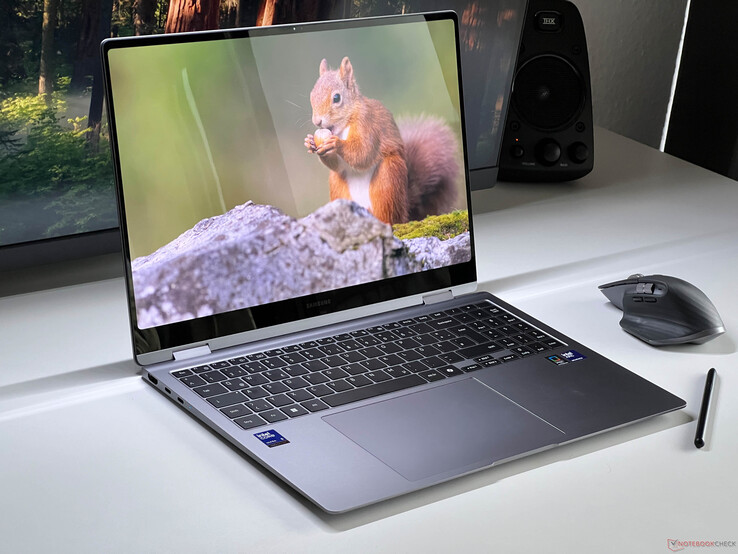











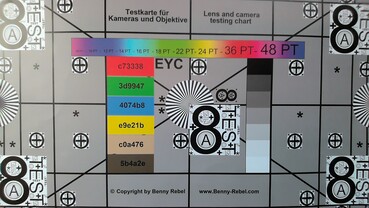

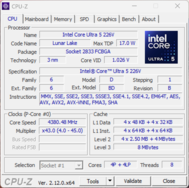
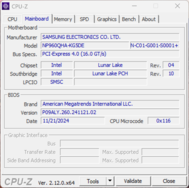
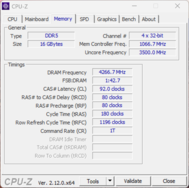
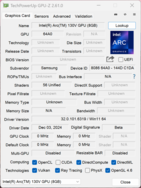
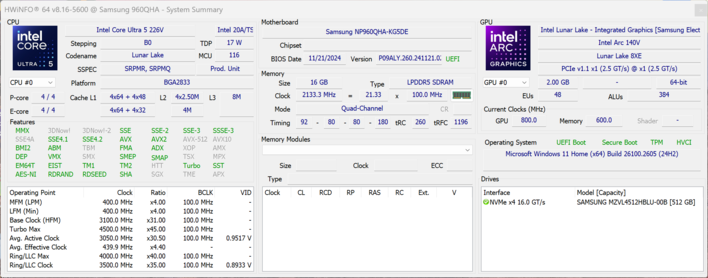
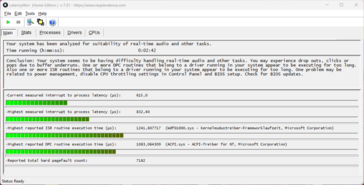
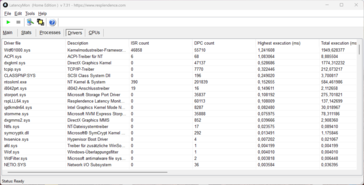

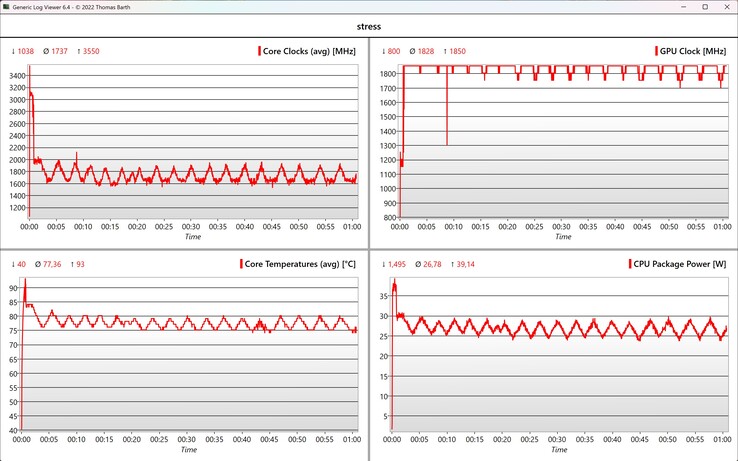
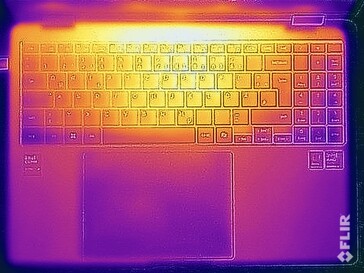
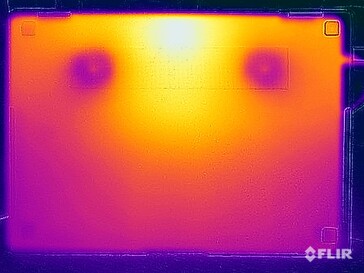
 Total Sustainability Score:
Total Sustainability Score: 








